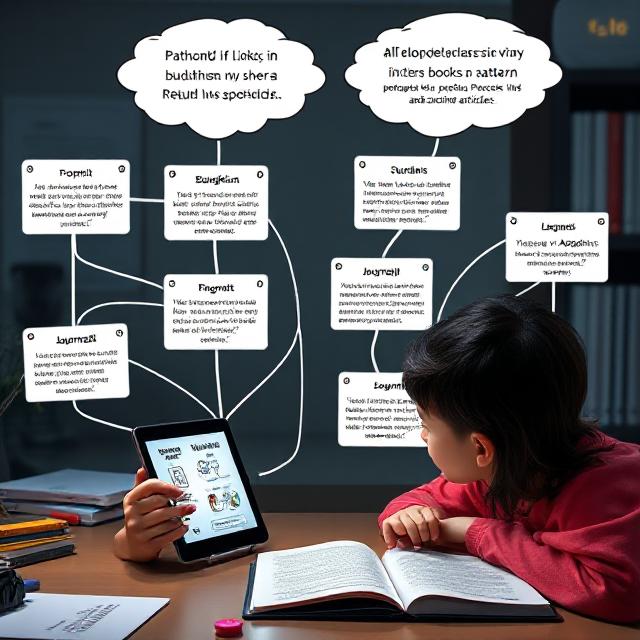
Table of Contents
Syntopic Flashcard Creation: Multi-Topic Recall Tips
Traditional flashcards test isolated facts. While useful for drilling names, dates, or definitions, they fall short when it comes to deep understanding, transfer learning, and cross-topic thinking.
That’s where syntopic flashcard creation steps in.
Instead of reinforcing fragmentation, syntopic flashcards are designed to connect concepts across sources, themes, or domains. They mimic how real-life knowledge works—interconnected, contextual, and adaptive. This method strengthens long-term recall, promotes higher-order thinking, and makes flashcard review more engaging and brain-friendly.
In this guide, you’ll learn how to build flashcards that don’t just test memory—they train synthesis.
🧠 Why Typical Flashcards Aren’t Enough
Flashcards often fall into one of these traps:
- Too narrow: “What’s the definition of X?”
- Too passive: Recalling without context or reflection
- Too fragmented: No connection to other ideas or real-world usage
They help you cram—but not comprehend.
Neuroscience shows that meaningful, connected learning activates long-term memory more effectively than rote repetition. And that’s exactly what syntopic flashcards deliver: they embed knowledge in patterns and principles.
🔄 What Makes a Flashcard “Syntopic”?
Syntopic flashcards intentionally:
- Integrate ideas from multiple sources or domains
- Ask for comparison, synthesis, or application
- Reflect contradictions, perspectives, or historical shifts
- Train the learner to move between models or contexts
Instead of asking, “What is neuroplasticity?” a syntopic card might ask:
“How does neuroplasticity support both mindfulness and skill acquisition? Use two sources.”
🧩 Core Elements of Syntopic Flashcards
1. Cross-Linking Prompts
Encourage recall across disciplines.
- ❌ “Define photosynthesis.”
- ✅ “How does photosynthesis compare to mitochondrial energy production?”
2. Multi-Source Referencing
Pull from diverse readings or lectures.
- ❌ “Summarize Nietzsche’s view of morality.”
- ✅ “Contrast Nietzsche’s morality with Confucius. What tensions emerge?”
3. Pattern Recognition
Train your brain to spot deep structure.
- ❌ “What’s a fixed mindset?”
- ✅ “What recurring patterns connect fixed mindsets, trauma beliefs, and learned helplessness?”
4. Synthesis Tasks
Ask for creative integration.
- ❌ “What is classical conditioning?”
- ✅ “Design a classroom ritual using both classical conditioning and gamified feedback.”
🛠️ How to Build a Syntopic Flashcard System
Here’s a 5-step method for creating and using syntopic flashcards effectively:
Step 1: Choose a Central Theme
Pick a topic broad enough to invite comparison.
Examples:
- Metabolic flexibility
- Stoicism vs Existentialism
- Memory consolidation mechanisms
Step 2: Gather 3–5 Contrasting Sources
Pull in at least three types of input:
- Textbook or academic source
- Podcast or lecture
- Blog, news, or personal reflection
- Visuals (charts, infographics)
This fuels diverse insight.
Step 3: Craft High-Cognition Prompts
Use Bloom’s Taxonomy to guide your flashcard questions.
Focus on:
- Compare / Contrast
- Apply / Illustrate
- Explain how / Why not
- Create / Predict
Step 4: Tag for Schema Layers
Organize your flashcards by:
- Source type
- Theme or schema
- Thinking mode (Compare, Apply, Create, etc.)
This helps you randomize intelligently during review.
Step 5: Space & Shuffle
Use spaced repetition software like Anki—but not blindly.
- Interleave different topics
- Shuffle Bloom’s levels
- Occasionally reverse the prompt to explain it from the answer
🧠 Example Decks: Syntopic Flashcards in Action
📚 Philosophy Deck
Card: “How does the Buddhist concept of non-self challenge Descartes’ cogito?”
Sources: Meditations on First Philosophy, The Heart Sutra, Sam Harris podcast
🔬 Biology Deck
Card: “Compare the mechanisms of autophagy and apoptosis. What determines the cell’s choice?”
Sources: OpenStax Biology, David Sinclair interview, research journal on cell death
🌎 Global Ethics Deck
Card: “What moral dilemmas arise when comparing utilitarian and deontological responses to AI ethics?”
Sources: Kant’s Groundwork, Sam Altman interview, UN AI ethics paper
🧪 Biohacking Deck
Card: “Create a 3-day protocol combining fasting, sleep timing, and light exposure for dopamine balance.”
Sources: Andrew Huberman, circadian biology journal, biohacking forum threads
✍️ Prompt Styles to Practice
| Prompt Type | Example |
|---|---|
| Compare | “Compare the roles of insulin and cortisol in energy regulation.” |
| Apply | “Use Maslow’s hierarchy to redesign your current workspace.” |
| Explain | “Why does syntopic learning improve long-term memory?” |
| Predict | “What happens to focus if sodium intake drops below baseline?” |
| Design | “Create a morning routine using ideas from Stoicism and circadian neuroscience.” |
This diversity enhances cognitive flexibility, a predictor of problem-solving, creativity, and lifelong learning.
🧠 How the Brain Responds to Syntopic Cards
Better Recall
You’re activating multiple memory traces: the hippocampus loves when information connects across schemas.
Pattern Recognition
The prefrontal cortex gets stronger as you juggle complexity, ambiguity, and contradiction.
Long-Term Storage
When you revisit an idea in different contexts, you encode it more robustly (the variation effect).
Transfer Learning
Syntopic flashcards train your brain to use knowledge, not just remember it. This builds the transfer muscle that helps with:
- Solving real problems
- Debating effectively
- Designing from first principles
🧭 Tips for Mastery
- Limit review sessions to 20–30 min to avoid fatigue
- Always write your own—premade decks rarely go deep enough
- Use a journal alongside your cards to record synthesis insights
- Pair with mind maps or diagrams for visual schema building
- Mix emotional + factual cards (e.g., “Which idea triggered you, and why?”)
🧬 Final Thoughts: Flashcards That Think
Syntopic flashcard creation transforms memorization into interactive synthesis. By prompting multi-angle recall, it helps you internalize truth, not just parrot facts.
In a world full of scattered information, the edge goes to those who can connect dots, reframe knowledge, and think in layers.
Don’t just memorize. Rewire.
Don’t just review. Synthesize.
Don’t just pass tests. Build mental models that last a lifetime.